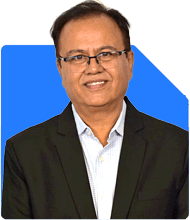How can I secure my 8-year-old son's future with a 27,000 INR monthly income?
Ramalingam Kalirajan |10878 Answers |Ask -Follow
Mutual Funds, Financial Planning Expert - Answered on Nov 12, 2024
He has an MBA in finance from the University of Madras and is a certified financial planner.
He is the director and chief financial planner at Holistic Investment, a Chennai-based firm that offers financial planning and wealth management advice.... more

Meri age 43 hai, private job h, meri month income 27000/ hain jo mere in hand 25600/- aati hain, meri koi alag se income nhi hain, Mera beta h jo abhi 8 year ka h, uska future kasie secure kru, family ke sath hi rehta hu, main aisa kya kru jisse meri monthly income bhi save ho sake. Or retirement ka koi issue na ho.
Current Financial Overview
You are 43 years old and working in a private job with a monthly income of Rs 27,000, leaving you Rs 25,600 in hand. You have one son, aged 8, and no other income source. Ensuring a balance between saving, investing, and securing your son’s future is essential.
Steps for Financial Security and Savings
Establish an Emergency Fund
Start with building an emergency fund to cover 3-6 months of living expenses. This will ensure you’re financially protected during unexpected situations. Consider liquid funds or a recurring deposit, as they offer ease of access while keeping your funds safe.
Allocate for Child’s Education
Start saving specifically for your son's higher education. By beginning early, you can spread out contributions. Consider options that offer stable growth, such as child-specific mutual funds or balanced funds, which are professionally managed and aligned with long-term goals. Regular contributions through a Systematic Investment Plan (SIP) will help gradually accumulate a sizable corpus.
Focus on Retirement Planning
Retirement planning should be approached with a clear goal in mind. Assess how much you will need to maintain your lifestyle post-retirement. Aim for investments that provide growth along with some stability, like diversified mutual funds or balanced funds, as these allow capital appreciation over time. Investing regularly will help ease the burden and grow your retirement corpus without impacting your monthly income significantly.
Health Insurance Protection
Health-related expenses can strain finances. Ensure you have adequate health insurance coverage to safeguard yourself and your family from unexpected medical costs. This will preserve your savings and protect your family’s well-being.
Life Insurance for Financial Security
Opt for term life insurance to provide a financial cushion for your family. This policy would offer your family a lump sum to cover essential expenses in case of an unfortunate event. Avoid investment-linked insurance as it may not give optimal returns compared to pure investment options like mutual funds.
Maximising Your Investment Returns
Mutual Fund Investments
Actively managed mutual funds can offer potentially higher returns than index funds. With an experienced Certified Financial Planner, you can choose funds managed by experts aiming to outperform the market. Through a Systematic Investment Plan (SIP), you can invest small amounts regularly, making it easier to save consistently.
Avoid Direct Funds; Choose Regular Funds
Direct funds can seem cost-effective, but they lack the benefit of expert guidance. Investing through a Certified Financial Planner helps you make informed choices, balancing risk and returns. Regular funds, guided by a CFP, ensure professional management and support, especially in adapting to market changes.
Tax-Efficient Investing
The recent changes in capital gains tax are important to understand. For equity mutual funds, long-term capital gains above Rs 1.25 lakh are taxed at 12.5%, while short-term capital gains are taxed at 20%. For debt mutual funds, both short-term and long-term gains are taxed as per your income slab. Planning your investments to align with these tax rules will help you maximize post-tax returns.
Budgeting and Expense Management
Set Up a Budget to Track Savings
A budget will help you control expenses and save more. Separate essential expenses like household needs, utilities, and education from non-essentials. Aim to save at least 10-15% of your monthly income towards investments.
Automate Savings
Automate your SIPs and other recurring savings. This disciplined approach ensures that savings are set aside first before other expenses. Automation also reduces the chances of missing contributions, allowing your investments to grow steadily.
Regular Financial Reviews
Review Your Financial Plan Annually
Review your financial plan and investment portfolio yearly. Adjust your strategy if there are changes in your income, expenses, or goals. A Certified Financial Planner can provide valuable insights and updates to keep you on track.
Final Insights
A structured, disciplined approach is key to building a secure financial future. By focusing on your son’s education, retirement, and emergency savings, you’re laying a foundation for financial independence and security. Remember, small but consistent efforts will help you achieve your financial goals with time.
Best Regards,
K. Ramalingam, MBA, CFP,
Chief Financial Planner,
www.holisticinvestment.in
https://www.youtube.com/@HolisticInvestment
You may like to see similar questions and answers below
Sunil Lala | Answer |Ask -Follow
Financial Planner - Answered on Feb 26, 2024
Ramalingam Kalirajan |10878 Answers |Ask -Follow
Mutual Funds, Financial Planning Expert - Answered on Jul 25, 2024
Ramalingam Kalirajan |10878 Answers |Ask -Follow
Mutual Funds, Financial Planning Expert - Answered on Jul 27, 2024
Ramalingam Kalirajan |10878 Answers |Ask -Follow
Mutual Funds, Financial Planning Expert - Answered on May 18, 2025
Samraat Jadhav |2506 Answers |Ask -Follow
Stock Market Expert - Answered on Dec 11, 2025
Samraat Jadhav |2506 Answers |Ask -Follow
Stock Market Expert - Answered on Dec 11, 2025
Samraat Jadhav |2506 Answers |Ask -Follow
Stock Market Expert - Answered on Dec 11, 2025
Dr Nagarajan J S K |2577 Answers |Ask -Follow
NEET, Medical, Pharmacy Careers - Answered on Dec 10, 2025
Mayank Chandel |2570 Answers |Ask -Follow
IIT-JEE, NEET-UG, SAT, CLAT, CA, CS Exam Expert - Answered on Dec 10, 2025
Samraat Jadhav |2506 Answers |Ask -Follow
Stock Market Expert - Answered on Dec 10, 2025
Radheshyam Zanwar |6741 Answers |Ask -Follow
MHT-CET, IIT-JEE, NEET-UG Expert - Answered on Dec 10, 2025
Ramalingam Kalirajan |10878 Answers |Ask -Follow
Mutual Funds, Financial Planning Expert - Answered on Dec 10, 2025
Ramalingam Kalirajan |10878 Answers |Ask -Follow
Mutual Funds, Financial Planning Expert - Answered on Dec 10, 2025
Samraat Jadhav |2506 Answers |Ask -Follow
Stock Market Expert - Answered on Dec 10, 2025


























